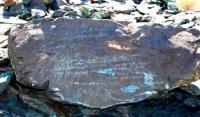Вы здесь
Tamerlan plate on Altynshoky mountain.

Flower Tours in Ulytau.
“For everything in this journey of life we are on, there is a right wing and a left wing: for the wing of love there is anger; for the wing of destiny there is fear; for the wing of pain there is healing; for the wing of hurt there is forgiveness; for the wing of pride there is humility; for the wing of giving there is taking; for the wing of tears there is joy; for the wing of rejection there is acceptance; for the wing of judgment there is grace; for the wing of honor there is shame; for the wing of letting go there is the wing of keeping. We can only fly with two wings and two wings can only stay in the air if there is a balance. Two beautiful wings is perfection. There is a generation of people who idealize perfection as the existence of only one of these wings every time. But I see that a bird with one wing is imperfect. An angel with one wing is imperfect. A butterfly with one wing is dead. So this generation of people strive to always cut off the other wing in the hopes of embodying their ideal of perfection, and in doing so, have created a crippled race”
C. JoyBell C.
Photo Gallery Ulytau.
The Tamerlane plate is located on the Altynshoky mountain 453 meters above sea level in the north-west of the Ulytau mountains and in the southeast of the Zhylynshyk Turme upland, between the Zhetikyz and Usabay bulak rivers, 12.1 kilometers to the west and slightly north of the Sarlyk village, in 42.1 kilometers northwest of the Ulytau village in the Ulytau district of the Ulytau region.
Not far from the village of Sarlyk, there is a remarkable place associated with another great conqueror, whose name is forever inscribed in world history. It was through these lands that the ruler of Maverannahr, the great emir Timur, also known in history as Tamerlane, passed in 1391.
And it was here, on the Altynshoky hill, that he left, in fact, the only documentary evidence of his campaign against the Golden Horde and of Tokhtamysh Khan. From Tashkent, a huge army of Tamerlane moved through Betpak-Dala (Hungry Steppe) and approximately, by April, reached the spurs of Ulytau.
Realizing that for Khan Tokhtamysh these lands are very significant ancestral possessions, it was here, in line of sight from the Ulytau mountains, on the top of the Altynshoky hill, that Tamerlane decided to leave a reminder of his campaign.
According to one version, he ordered each of his soldiers to bring a stone to the top of the hill, thus building a stone mound. And already in the vicinity of the mound, the commander ordered to install a sign, that is, a plate with an inscription engraved on it.
What was embossed on the plate? The most detailed and scientifically recognized translation reads as follows:
"In the name of Allah, the merciful, the merciful! The Lord of existence, the Sanctuary of truth, Vigilant defender, Omnipotent and omnipotent, the Wise giver of life and death! In the year seven hundred ninety-three, in the middle month of the spring of the year of the sheep, the Sultan of Turan Timur-bek rose with three hundred thousand troops for Islam to the Bulgar khan Tokhtamysh-khan. Having reached this area, he erected this mound to be a memorial sign. God willing, may the Lord do justice! May the Lord show mercy to people."
Nowadays, at the top of the hill, you can find a huge melting furnace (confirmation of this is the blowing, as well as the mass of melted stones). Scientists believe that this furnace was intended for the primary processing of ore, most likely lead.
According to one of the legends, in this smelting furnace, Tamerlane, already returning from the campaign, ordered to burn all the stolen riches, thus demonstrating that the purpose of his campaign was not enrichment, but restoration of justice and punishment of Tokhtamysh.
Almost all sources say that Kanysh Satpayev is the discoverer of this slab. However, this is not entirely true, since its whereabouts were known much earlier. So, for example, on the French "Map of Tartary" by Guillaume Delisle, published in 1706, next to the mountains "Oulouc Tac" there is a place called "Icy Tamerlan sit elever une Auguille avec la date de son expeditio" ("here Tamerlan erected sign with the date of his expedition").
Thus, Satpayev only found something that was already known to exist. According to one version, Satpayev discovered a stone slab with an inscription engraved on it himself, according to another, local residents showed him this slab. This happened, according to available information, in 1935. The following year, a scientific expedition was sent here, the purpose of which was to deliver the slab to Leningrad, more precisely, to the Hermitage.
The slab was delivered to Karsakpai (by the way, this slab is often called the Karsakpai inscription, after the name of the nearest large settlement), and from there to the Zhosaly station, and then by rail to Leningrad. The slab came to the Hermitage at the end of 1936, and then its scientific study began.
By the way, the slab is still in the Hermitage, and a copy of it has been installed on the Altynshoky Hill.
Geographic coordinates of Tamerlane Plate on Altynshoky Mountain: N48°46'30.91 "E66°27'38
Authority and photos by:
Vitaly Shuptar. www.guide.kz
Alexander Petrov.







